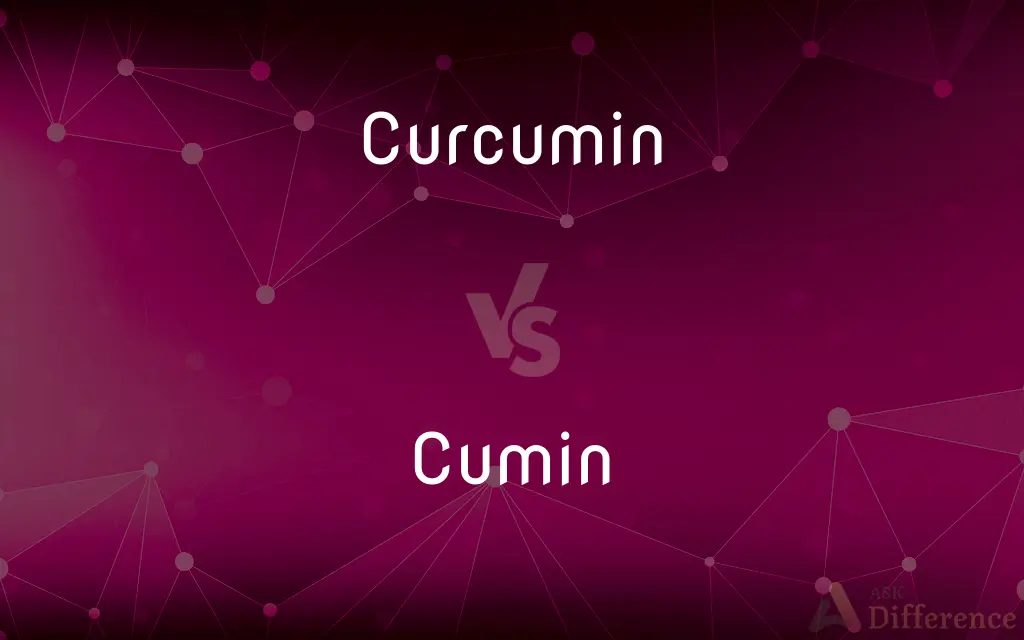Curcumin vs. Cumin — What's the Difference?
Edited by Tayyaba Rehman — By Urooj Arif — Updated on May 16, 2024
Curcumin is a bioactive compound found in turmeric, known for its anti-inflammatory and antioxidant properties, while cumin is a spice made from the seeds of the Cuminum cyminum plant, used to flavor foods.

Difference Between Curcumin and Cumin
Table of Contents
ADVERTISEMENT
Key Differences
Curcumin is a natural compound found in turmeric, a yellow spice commonly used in Indian cuisine and traditional medicine. It is renowned for its potent anti-inflammatory and antioxidant properties, which contribute to its use in various health supplements and treatments. Cumin, on the other hand, is a spice derived from the dried seeds of the Cuminum cyminum plant. It is widely used in cooking for its distinct warm and earthy flavor, especially in Middle Eastern, Indian, and Mexican cuisines.
Curcumin is specifically a chemical constituent of turmeric and is primarily used for its medicinal properties rather than its taste. It is the component that gives turmeric its bright yellow color and is often extracted and concentrated in dietary supplements. Conversely, cumin is a whole spice used directly in cooking, providing flavor and aroma to a variety of dishes.
While curcumin is studied extensively for its health benefits, cumin also offers some health advantages, including aiding digestion and providing essential nutrients like iron. However, cumin's primary role is culinary, enriching the flavor profile of foods.
Curcumin requires additional compounds, such as piperine from black pepper, to enhance its bioavailability when consumed. In contrast, cumin can be directly used in cooking without any such requirement. The focus of curcumin is more on its therapeutic potential, while cumin is cherished for its culinary versatility.
Comparison Chart
Definition
Bioactive compound in turmeric
Spice made from the seeds of the Cuminum cyminum plant
ADVERTISEMENT
Primary Use
Medicinal purposes
Culinary purposes
Health Benefits
Anti-inflammatory, antioxidant
Aids digestion, provides nutrients
Source
Turmeric
Cuminum cyminum seeds
Usage in Cooking
Rarely used directly in cooking
Widely used in various cuisines
Bioavailability
Requires enhancers like piperine for absorption
Directly used without additional compounds
Appearance
Bright yellow color
Brown, oblong seeds
Compare with Definitions
Curcumin
A compound that needs piperine to enhance its absorption in the body.
Adding black pepper to turmeric enhances curcumin's bioavailability.
Cumin
A spice made from the dried seeds of the Cuminum cyminum plant.
Cumin adds a warm, earthy flavor to many Middle Eastern dishes.
Curcumin
A substance studied for its potential role in managing chronic diseases.
Researchers are investigating curcumin's effects on heart health.
Cumin
A common ingredient in spice blends like curry powder and chili powder.
The recipe calls for ground cumin to enhance the stew's taste.
Curcumin
A bioactive compound found in turmeric, known for its health benefits.
Curcumin supplements are popular for their anti-inflammatory properties.
Cumin
A spice used to flavor food and aid digestion.
Cumin tea is sometimes consumed to help with digestive issues.
Curcumin
The primary pigment that gives turmeric its yellow color.
The bright yellow hue of the curry is due to the curcumin in turmeric.
Cumin
A plant whose seeds are used as a spice in cooking.
Cumin seeds can be roasted to bring out their aromatic flavor.
Curcumin
An antioxidant compound used in traditional medicine.
Curcumin is used in Ayurvedic treatments for its healing effects.
Cumin
A culinary spice known for its distinctive taste and aroma.
The distinctive taste of the taco seasoning comes from cumin.
Curcumin
Curcumin is a bright yellow chemical produced by plants of the Curcuma longa species. It is the principal curcuminoid of turmeric (Curcuma longa), a member of the ginger family, Zingiberaceae.
Cumin
Cumin ( or US: , or ) (Cuminum cyminum) is a flowering plant in the family Apiaceae, native to the Irano-Turanian Region. Its seeds – each one contained within a fruit, which is dried – are used in the cuisines of many cultures in both whole and ground form.
Curcumin
A phytochemical found in turmeric and other species in the genus Curcuma that is used in alternative medicine and is purported to have anti-inflammatory and anticancer properties.
Cumin
An annual Mediterranean herb (Cuminum cyminum) in the parsley family, having finely divided leaves and clusters of small white or pink flowers.
Curcumin
(chemistry) A polyphenol (1E,6E)-1,7-bis(4-hydroxy-3-methoxyphenyl)hepta-1,6-diene-3,5-dione; a major constituent of the spice turmeric.
Cumin
The seedlike fruit of this plant used whole or ground for seasoning, as in curry and chili powders.
Curcumin
The coloring principle of turmeric, or curcuma root, extracted as an orange yellow crystalline substance, C14H14O4, with a green fluorescence.
Cumin
Black cumin.
Cumin
The flowering plant Cuminum cyminum, in the family Apiaceae.
Cumin is native to the region from the eastern Mediterranean to India.
Cumin
Its aromatic long seed, used as a spice, notably in Indian, Middle Eastern, and Mexican cookery.
Cumin
A dwarf umbelliferous plant, somewhat resembling fennel (Cuminum Cyminum), cultivated for its seeds, which have a bitterish, warm taste, with an aromatic flavor, and are used like those of anise and caraway.
Rank-smelling rue, and cumin good for eyes.
Cumin
Dwarf Mediterranean annual long cultivated for its aromatic seeds
Cumin
Aromatic seeds of the cumin herb of the carrot family
Common Curiosities
What is cumin?
Cumin is a spice made from the seeds of the Cuminum cyminum plant, used to flavor foods.
Can curcumin be used in cooking?
Curcumin is not typically used directly in cooking; turmeric, which contains curcumin, is used instead.
What are the primary uses of curcumin?
Curcumin is primarily used for its medicinal properties, including reducing inflammation and acting as an antioxidant.
Is cumin beneficial for health?
Yes, cumin aids digestion and provides essential nutrients like iron.
How is cumin used in cooking?
Cumin is used as a spice to enhance the flavor of various dishes, especially in Middle Eastern, Indian, and Mexican cuisines.
Can cumin be consumed directly?
Yes, cumin seeds or ground cumin can be directly added to food without any additional compounds.
Can curcumin be taken as a supplement?
Yes, curcumin is available in supplement form for its health benefits.
Is cumin part of turmeric?
No, cumin and turmeric are separate spices from different plants.
Does cumin have antioxidant properties?
Cumin has some antioxidant properties, but it is primarily used for its flavor and digestive benefits.
What is curcumin?
Curcumin is a bioactive compound found in turmeric, known for its anti-inflammatory and antioxidant properties.
Does curcumin need anything to enhance its absorption?
Yes, curcumin's bioavailability is enhanced by piperine, found in black pepper.
What dishes commonly use cumin?
Dishes like curries, stews, tacos, and spice blends often include cumin.
Is curcumin a spice?
No, curcumin is a compound found in the spice turmeric.
What form does curcumin typically come in?
Curcumin is often found in powdered turmeric or as concentrated supplements.
What are the health benefits of curcumin?
Curcumin has anti-inflammatory, antioxidant, and potential disease-fighting properties.
Share Your Discovery

Previous Comparison
Mom vs. Son
Next Comparison
Graveness vs. GravityAuthor Spotlight
Written by
Urooj ArifUrooj is a skilled content writer at Ask Difference, known for her exceptional ability to simplify complex topics into engaging and informative content. With a passion for research and a flair for clear, concise writing, she consistently delivers articles that resonate with our diverse audience.
Edited by
Tayyaba RehmanTayyaba Rehman is a distinguished writer, currently serving as a primary contributor to askdifference.com. As a researcher in semantics and etymology, Tayyaba's passion for the complexity of languages and their distinctions has found a perfect home on the platform. Tayyaba delves into the intricacies of language, distinguishing between commonly confused words and phrases, thereby providing clarity for readers worldwide.
















































